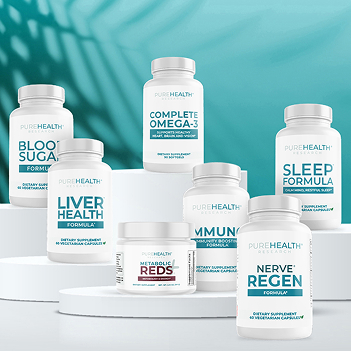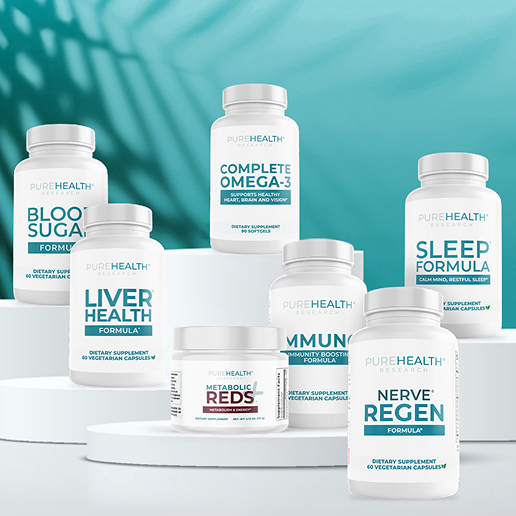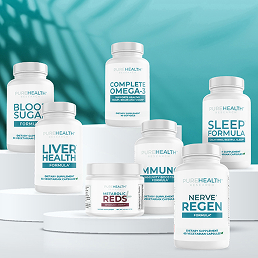Does Soy Sauce Cause Heartburn?
Does soy sauce cause heartburn? Not typically, but those sensitive to sodium or MSG may experience acid reflux. Learn what helps.


Soy sauce typically doesn’t cause heartburn in most people, but it can trigger symptoms if you’re sensitive to high-sodium foods or fermented products. The combination of salt and fermentation may increase stomach acid production in some individuals. Let’s explore whether your favorite Asian condiment might be contributing to that burning sensation.
What Is Heartburn and Acid Reflux?
Heartburn happens when stomach acid backs up into your esophagus, creating a burning sensation in your chest. This occurs when the valve between your stomach and esophagus doesn’t close properly. The result is an uncomfortable burning feeling that can last minutes or hours.
Acid reflux is the actual movement of stomach contents upward, while heartburn is the symptom you feel. Common signs include a sour taste in your mouth, difficulty swallowing, and chest discomfort that worsens when lying down. These symptoms often appear after eating certain foods or large meals.
Several factors contribute to acid reflux, including excess weight, eating habits, and specific food choices. Your digestive system’s sensitivity plays a major role in determining which foods trigger symptoms. Identifying your personal triggers is the first step toward managing discomfort effectively.
Can Soy Sauce Cause Heartburn?
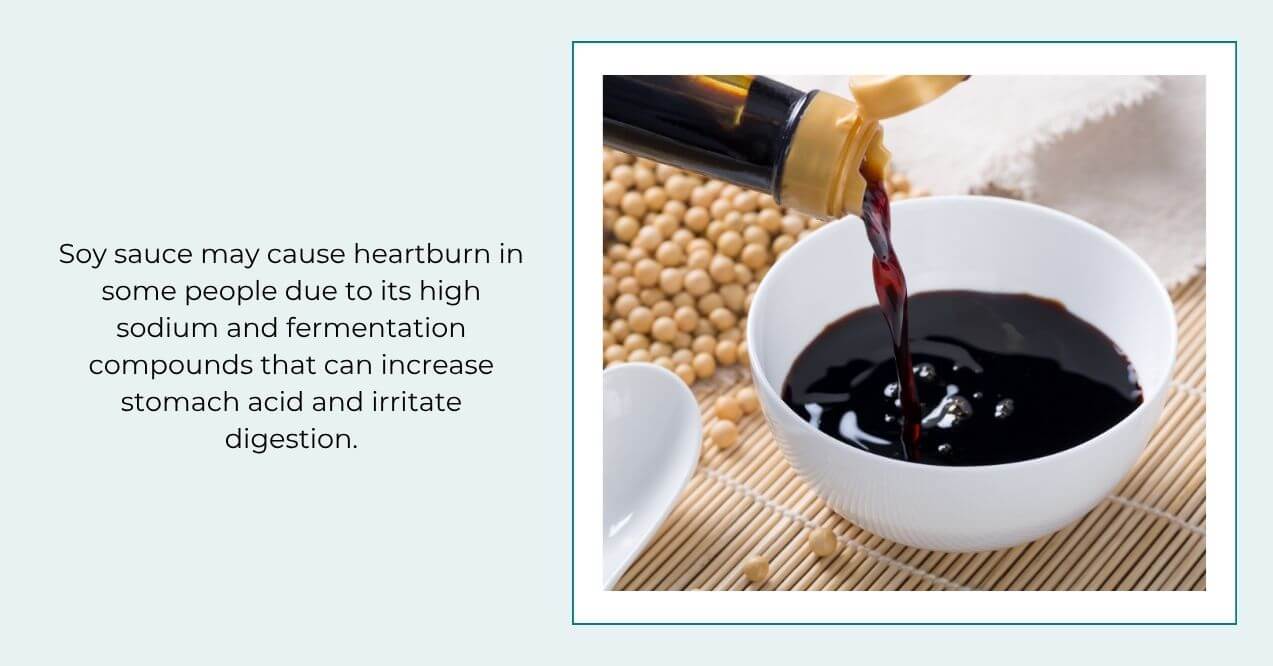
Does soy sauce cause heartburn? For most people, soy sauce alone won’t trigger acid reflux symptoms. However, individuals sensitive to high-sodium foods or fermented products may experience discomfort after consuming it. The answer largely depends on your personal digestive sensitivity and how much you consume.
The sodium content in regular soy sauce ranges from 800 to 1,000 milligrams per tablespoon. This high salt concentration might stimulate excess stomach acid production in sensitive individuals. When combined with other trigger foods, soy sauce reflux symptoms may become more noticeable.
The fermentation process used to make soy sauce creates compounds that some digestive systems find irritating. These naturally occurring substances, along with the high salt content, can contribute to acid reflux soy sauce reactions. Your body’s response depends on factors like overall diet, stress levels, and existing digestive conditions.
The Role of Salt
High sodium intake directly affects stomach acid production by stimulating gastric secretions. When you consume salty foods like soy sauce, your stomach may produce more acid to process the sodium. This increased acid production can overwhelm the esophageal valve, especially if it’s already weakened.
Salt also causes water retention, which can increase pressure on your stomach. This added pressure makes it easier for stomach contents to push upward into the esophagus. For those asking can soy sauce cause acid reflux, the sodium content is often the primary concern.
Preservatives and Additives
Many commercial soy sauce brands contain additives like monosodium glutamate (MSG) and various preservatives. These ingredients might trigger digestive sensitivity in some people, leading to increased acid production. Natural fermentation creates beneficial compounds, but artificial additives may cause irritation.
Some individuals react to the histamines naturally present in fermented foods. These compounds can cause digestive upset and contribute to acid reflux symptoms. Choosing naturally brewed soy sauce without added chemicals may reduce your risk of experiencing heartburn.
Other Foods That Can Trigger Heartburn
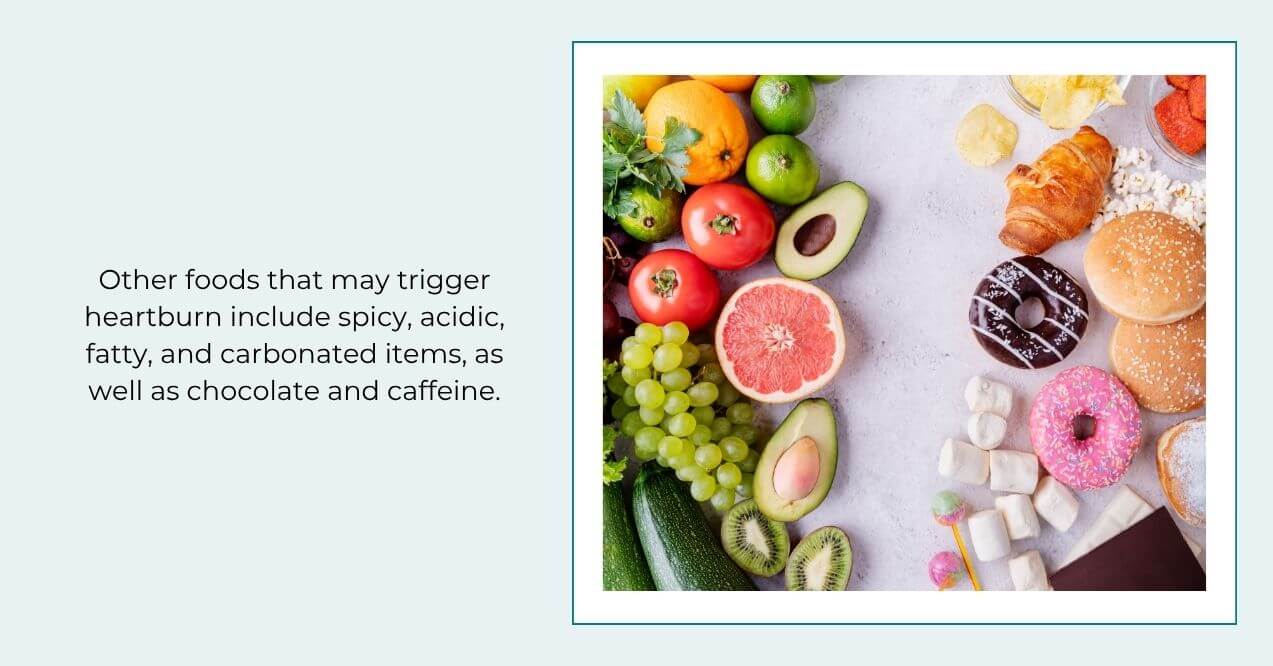
While investigating whether soy sauce causes heartburn, it’s helpful to compare it to other common trigger foods. Spicy dishes top the list, as peppers and hot spices can irritate the esophageal lining directly. These foods often appear alongside soy sauce in Asian cuisine, potentially creating a double trigger effect.
Citrus fruits and tomato-based products contain natural acids that can worsen reflux symptoms. Oranges, lemons, and tomato sauce have pH levels that may overwhelm your esophageal valve. When combined with salty condiments, these acidic foods can create the perfect storm for heartburn.
Chocolate and caffeine relax the lower esophageal valve, making it easier for stomach acid to escape. Many people wonder why certain unexpected foods like bananas can trigger symptoms, discovering that individual sensitivities vary greatly. Fatty foods slow digestion, keeping food in your stomach longer and increasing reflux risk.
Carbonated beverages add another layer of complexity to digestive issues. The bubbles create pressure in your stomach, forcing acid upward. Knowing your personal trigger foods helps you make better choices, and some find that milk may help neutralize acid temporarily.
How to Prevent Heartburn from Soy Sauce
Managing potential soy sauce reflux doesn’t mean giving up your favorite Asian dishes entirely. Simple adjustments to how and when you consume soy sauce can make a significant difference. Portion control remains one of the most effective strategies for preventing discomfort.
Timing matters when enjoying foods that might trigger acid reflux. Avoid consuming soy sauce-heavy meals within three hours of bedtime. Your digestive system needs time to process sodium and fermented compounds before you lie down.
Consider your overall meal composition when using soy sauce. Pairing it with FODMAP-friendly foods can help reduce digestive stress. Creating balanced meals that include plenty of vegetables and lean proteins can buffer the effects of high-sodium condiments.
Opt for Low-Sodium Soy Sauce
Low-sodium varieties contain up to 40% less salt than regular versions, significantly reducing potential triggers. These alternatives maintain the umami flavor while being gentler on your digestive system. Many brands now offer reduced-sodium options that taste nearly identical to traditional formulas.
Making the switch to low-sodium soy sauce is one of the easiest dietary changes you can implement. Start by gradually transitioning to allow your taste buds to adjust. You’ll likely find that you don’t miss the extra salt once you become accustomed to the lighter version.
Pair Soy Sauce with Non-Acidic Foods
Strategic food pairing can minimize the risk of acid reflux soy sauce reactions. Rice, steamed vegetables, and lean proteins like chicken or tofu create a buffer against acidity. These foods help absorb excess stomach acid and slow the digestive process in beneficial ways.
Avoid combining soy sauce with other known trigger foods in the same meal. Skip the spicy sriracha or acidic lime juice when using soy sauce. Instead, focus on mild flavors that complement without overwhelming your digestive system.
Consider Natural Alternatives
Coconut aminos offer a lower-sodium alternative with a slightly sweet flavor profile. This soy-free option contains about 65% less sodium than traditional soy sauce. Many people find it easier to digest while still providing that savory taste.
Tamari, a gluten-free soy sauce variant, may be gentler for some individuals. Liquid aminos provide another option with controlled sodium levels and no fermentation. Experimenting with these alternatives helps you find what works best for your digestive comfort.
Try Digestive Support Supplements
In addition to dietary adjustments, targeted digestive support supplements can help minimize occasional discomfort after meals. Gastro Health Formula is designed to promote balanced digestion with natural ingredients like licorice root, slippery elm, ginger, and marshmallow root. These botanicals work synergistically to soothe the digestive tract, support acid balance, and maintain a healthy gut environment.
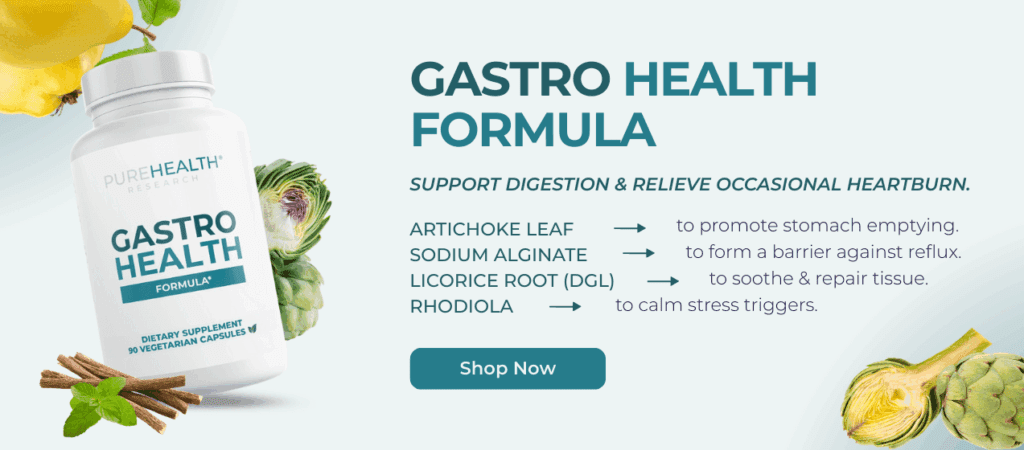
Taking a supplement like Gastro Health Formula regularly can help strengthen your digestive resilience, making it easier to enjoy flavorful foods like soy sauce without unwanted aftereffects.
When to Seek Medical Advice
Occasional heartburn after eating soy sauce or other trigger foods is usually manageable with lifestyle changes. However, experiencing symptoms more than twice a week may indicate a more serious condition. Persistent acid reflux can damage your esophagus over time and requires professional evaluation.
Watch for warning signs like difficulty swallowing, unexplained weight loss, or chest pain that doesn’t respond to antacids. These symptoms warrant immediate medical attention. Following a structured approach like a 7-day GERD diet plan can help identify patterns in your symptoms.
Your digestive health connects to your overall wellness in complex ways. Sometimes heartburn indicates underlying issues that need addressing. If you’ve recently experienced digestive disruption, learning how to restore gut health after stomach flu can help rebuild your system’s natural defenses.
Final Thoughts
Does soy sauce cause heartburn? For most people, moderate amounts won’t trigger symptoms, but those sensitive to sodium or fermented foods should exercise caution. The key lies in paying attention to your body’s signals and making informed choices about portion sizes and meal timing.
Soy sauce isn’t inherently bad for heartburn, but its high sodium content may trigger symptoms in sensitive individuals. The fermentation process and additives can also contribute to acid reflux in some people.
Tomato-based sauces, hot sauces, vinegar-based dressings, and citrus marinades commonly trigger heartburn. Creamy, high-fat sauces like alfredo can also cause symptoms by slowing digestion and increasing stomach pressure.
Common side effects include increased thirst, water retention, and potential blood pressure elevation from high sodium. Some people may experience digestive discomfort, headaches from MSG, or allergic reactions to soy or wheat ingredients.
Sign up for our Healthy Living newsletter!
Advertisement. This site offers health, wellness, fitness and nutritional information and is designed for educational purposes only. You should not rely on this information as a substitute for, nor does it replace, professional medical advice, diagnosis, or treatment. If you have any concerns or questions about your health, you should always consult with a physician or other health-care professional. Do not disregard, avoid or delay obtaining medical or health related advice from your health-care professional because of something you may have read on this site. The use of any information provided on this site is solely at your own risk.
